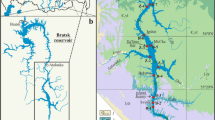Abstract
The chemical analysis of the water of Gaet’ale Pond, a small water body located in Danakil Depression, Ethiopia, resulted to be the most saline water body on earth with total dissolved solids (TDS) of 433 g kg−1. The composition of the water indicates the predominance of two main salts: CaCl2 and MgCl2 at a proportion of Ca:Mg = 3.1 (w/w). Traces of K+, Na+ and NO3 − are also detected, as well as Fe(III) complexes that give the water a characteristic yellow color. Density measurements, elemental analysis, thermogravimetrical analysis (TGA) and powder X-ray diffraction data are consistent with the composition and salinity determined. The water of this pond has a similar composition to Don Juan Pond, Antarctica, but a higher salinity, which can be explained in terms of temperature and solubility of the main components.





Similar content being viewed by others
References
Alipour S (2006) Hydrogeochemistry of seasonal variation of Urmia Salt Lake, Iran. Saline Syst 2:9–27
Aljubouri ZA, Aldabbagh SM (1980) Sinjarite, a new mineral from Iraq. Mineral Mag 43:643–645
Angino EE, Armitage KB (1963) Geochemical Study of Lakes Bonney and Vanda, Victoria Land, Antarctica. J Geol 71:89–95
Carniel R, Jolis EM, Jones J (2010) A geophysical multi-parametric analysis of hydrothermal activity at Dallol, Ethiopia. J Afr Earth Sci 58:812–819
Cartwright K, Harris HJH (1978) Origin of water in Lakes and Ponds of the Dry Valley Region, Antartica, D. V. D. P. Bulletin 88
Gebresilassie S, Tsegab SH, Kabeto K, Gebreyohannes T, Sewale A, Amare K, Mebrahtu A, Zerabruk S, Mebrahtu G, Gebrehiwot K, Haile M (2011) Preliminary study on geology, mineral potential and characteristics of hot springs from Dallol area, Afar rift, northeastern Ethiopia: implications for natural resource exploration, Momona Ethiop. J Sci 3:17–30
Green WJ, Lyons WB (2009) The Saline Lakes of the McMurdo Dry Valleys, Antarctica. Aquat Geochem 15:321–348
Hochstein MP, Browne PRL (2000) Surface manifestations of geothermal systems with volcanic heat sources. In: Sigurdsson H (ed) Encyclopedia of volcanoes. Academic Press, Cambridge
Horneck G, Baumstark-Khan C (eds) (2002) Astrobiology: the quest for the conditions of life. Springer, Berlin
Kosarev AN, Kostianoy AG, Zonn IS (2009) Kara-Bogaz-Gol Bay: physical and chemical evolution. Aquat Geochem 15:223–236
Lide DR (ed) (2000) CRC handbook of chemistry and physics, 81st edn. CRC Press, Boca Raton
Lightfoot WJ, Prutton CF (1947) Equilibria in saturated salt solutions. II. The ternary systems CaCl2–MgCl2–H2O, CaCl2–KCl–H2O and MgCl2–KCl–H2O at 75°. J Am Chem Soc 69:2098–2100
Master S (2016) Gaet’ale- a reactivated thermal spring and potential tourist hazard in the Asale salt flats, Danakil Depression, Ethiopia. J Appl Volcanol 5:1–9
Meybeck M (1995) Global distribution of lakes. In: Lerman A, Imboden D, Gat J (eds) Physics and chemistry of lakes, 2nd edn. Springer, Berlin
Perry R, Green D (1984) Perry’s chemical engineers’ handbook, 6th edn. McGraw-Hill International, New York
Pittwell LR (1972) Some coordination effect in natural waters of Ethiopia. J Hydrol 17:225–228
Riyaz N, Arakkal FR (2011) Spa therapy in dermatology, Indian. J Dermatol Venereol Leprol 77:128–134
Steinhorn I (1983) In situ precipitation at the Dead Sea. Limnol Oceanogr 28:580–583
Torii T, Osaka J (1965) Antarcticite: a new mineral, calcium chloride hexahydrate, discovered in Antarctica. Science 149:975–977
Torii T, Murata S, Yamagata N (1980) Chemistry of the Dry Valley Lakes. J R Soc N Z 11:387–399
Utah Water Research Laboratory (1972) The Great Salt Lake and Utah’s water resources, Paper 37; http://digitalcommons.usu.edu/water_rep/37
Ventosa A, Arahal DR (2009) Physico-chemical characteristics of hypersaline environments and their biodiversity. In: Gerday C, Glansdorff N (eds) Extremophiles, vol II. EOLSS Publishers, Oxford
Wenk H-R, Bulakh A (2004) Minerals, their Constitution and Origin. Cambridge University Press, Cambridge
Acknowledgements
The authors would like to thank Martyn Poliakoff, Mark Guyler, Peter Bayliss, Carlos Herreros from the School of Chemistry, University of Nottingham; Dolores Bermejo from the Chemical Engineering Faculty, University of Valladolid and Viktor Schmalz from Institut fuer Wasserchemie, TU Dresden. The authors also acknowledge Miguel Ángel Martínez, Eugenia Conde, Fekadu Mekuriaw and José Manuel Pérez.
Author information
Authors and Affiliations
Corresponding author
Rights and permissions
About this article
Cite this article
Pérez, E., Chebude, Y. Chemical Analysis of Gaet’ale, a Hypersaline Pond in Danakil Depression (Ethiopia): New Record for the Most Saline Water Body on Earth. Aquat Geochem 23, 109–117 (2017). https://doi.org/10.1007/s10498-017-9312-z
Received:
Accepted:
Published:
Issue Date:
DOI: https://doi.org/10.1007/s10498-017-9312-z




